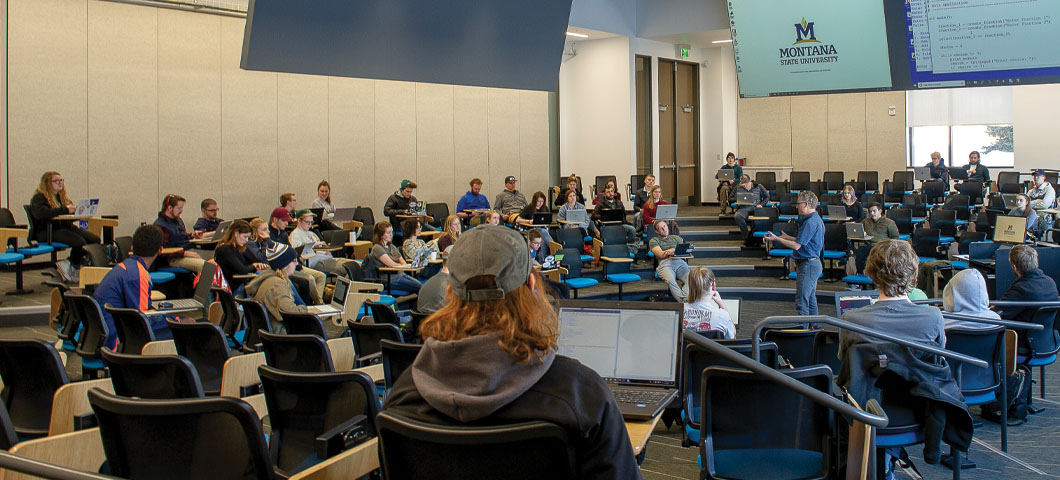Guide to Inclusive Teaching
Download a PDF version of this guide
 Photo credit: Kelly Gorham
Photo credit: Kelly Gorham
Teaching and learning spaces, whether physical or virtual, reflect the world around us. Research illustrates that students with underrepresented identities – related to race, gender, ability status and more – may face additional challenges in the classroom. By implementing inclusive teaching practices, faculty can create learning environments where all students feel a sense of belonging and can achieve their highest potential. These tips provide instructors with support for creating inclusive learning environments.
Create an Inclusive Classroom Climate
- Survey your students. Get to know your students and help them get to know you and each other. During the first week of classes, ask them about their interests and goals. Share the collated results, and integrate their interests into the course.
- Articulate guidelines for classroom interactions. Let students know what you expect from them in terms of how they interact with one another in class, whether in-person or online. This process helps to create a space where diverse viewpoints can be valued. Ask what they need in order to have a good learning experience. For example, co-construct a contract outlining expectations and tips for engaging in dialogue, especially around heated issues (e.g. a Brave Space Agreement).
- Set expectations for self-reflection and active listening. Talk with students about thinking of your class as an embodiment of an evolving community where everyone is learning and practicing being in better relationships with each other. Talk with students about using class as a place to practice building community.
- Check in with students regularly. Ask them how they are doing and what’s on their minds. Depending on class size, you may be able to go around the room and hear from each student.
- Use an intersectional lens to explore ideas about place, home, family, and community. “Intersectionality” refers to an analytical framework for understanding how one’s social and political identities are embedded in patterns of privilege and discrimination. Ask students to engage in a self-reflection activity about where they are from, how they grew up, what is important to them and how these factors influence their perspectives on course topics. Collect their anonymized responses and use them for a collaborative exploration of differences vis-à-vis existing power structures within the context of the course and/or academic discipline.
- Facilitate student connections. Provide ample time for students to get to know each other and start to develop a sense of belonging through small group activities and discussions.
- Include a land acknowledgement statement. These statements recognize and respect Indigenous Peoples as traditional stewards of the land and their ongoing relationship to it. Consider including one in your syllabus and discussing it at the beginning of the semester.
Develop Inclusive Teaching Styles and Practices
- Examine your own understandings and biases. As an instructor, you shape the classroom experience. Think about how your identities may affect your teaching. Consider your own attitudes towards diversity and inclusion topics and reflect on the assumptions you make about students. Recognizing your own perspectives and being open to learning are crucial to inclusive teaching.
- Use inclusive language. Learn and use correct names, pronunciations, and pronouns. Include your personal pronouns in your email signature.
- Offer flexible office hours. Consider holding both online and in-person sessions to accommodate students with different work schedules, commute times and family support structures.
- Diversify course materials. Make sure your course content represents diverse and underrepresented perspectives. See MSU Guide on Diversifying Course Content.
- Expand options for assessment. Grade anonymously when possible. Include both low-stakes and high-stakes assignments. Offer a few assessment options for assignments, preferably using different media that allow students to be creative, use skills, and tap into their passion.
- Design your content and instruction to meet accessibility guidelines. Teach in multiple modalities (a recorded video with captions, a text document, and/or an in-person session) to help students learn. The Universal Design for Learning (UDL) Framework is a useful tool for designing accessible content, which benefits all students, particularly as many disabilities are invisible. Learn more at ato.montana.edu/accessforall and udlguidelines.cast.org.
- Teach with humility. When you make a mistake, admit it. Model risk-taking and use mistakes as learning opportunities. Inclusive teaching is an ongoing process from one semester to the next and should be approached with a growth mindset.
Commit to Ongoing Learning about Diversity & Inclusion Work
A few ways to learn more about inclusive teaching:
- Participate in one of MSU’s professional development opportunities for diversity.
- Learning more about developing land acknowledgements at LandAcknowledgements.org
- Read up on stereotype threat and implicit bias. Claude M. Steele’s book, Whistling Vivaldi: How Stereotypes Affect Us and What We Can Do, is one useful resource.
- Read Brian Arao and Kristi Clemens 2013 article “From Safe Spaces to Brave Spaces: A New Way to Frame Dialogue around Diversity and Social Justice” in The Art of Effective Facilitation: Reflections for Social Justice Educators.
- Read up on intersectionality and power in Allan Johnson’s 3rd edition of Privilege, Power, and Difference.
Special thanks to the MSU working group of faculty and staff who generously shared their time and knowledge to compile this guide: Abbey Boyer, Anna Elliot, Jacqueline Frank, Barbara Komlos, Myleen Leary, Colleen McMilin, Madison Myers, Craig Ogilvie, Sarah Pennington, Lisa Verwys and project lead Karen deVries.

